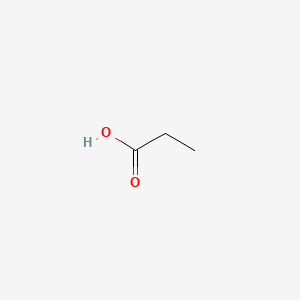
|
propionic acid |
propionic acid is a lipid of Fatty Acyls (FA) class. Propionic acid is associated with abnormalities such as Epilepsy, Infection, Tuberculosis, Alkalosis and Ischemia. The involved functions are known as Uptake, Biosynthetic Pathways, Methylation, Protein Overexpression and Biochemical Pathway. Propionic acid often locates in Body tissue, Cytoplasmic matrix, Membrane, Protoplasm and Extracellular. The associated genes with propionic acid are TRIO gene, TRRAP gene, SLC5A8 gene, SLC33A1 gene and Homologous Gene. The related lipids are Fatty Acids, Propionate, butyrate, Valerates and mycocerosic acid. |
7360 |

|
7-octadecynoic acid |
7-octadecynoic acid is a lipid of Fatty Acyls (FA) class. |
8379 |

|
Thapsigargin |
Thapsigargin is a lipid of Prenol Lipids (PR) class. Thapsigargin is associated with abnormalities such as Impaired glucose tolerance, Obesity and Blood Pressure Disorders. The involved functions are known as Phosphorylation, establishment and maintenance of localization, Regulation, Metabolic Inhibition and Proteolysis. Thapsigargin often locates in Mouse Skin, Cytoplasm, Skin, Protoplasm and Mitochondria. The associated genes with Thapsigargin are ERBB4 gene, F11 gene, CA1 gene, TRNAP1 gene and HSPA5 gene. The related lipids are taurolithocholic acid 3-sulfate, Liposomes, Fatty Acids and stearylamine. The related experimental models are Mouse Model. |
8868 |

|
minocycline |
minocycline is a lipid of Polyketides (PK) class. Minocycline is associated with abnormalities such as Infection, Soft Tissue Infections, Septicemia, Chronic hyponatremia and Lesion of brain. The involved functions are known as Pharmacodynamics, Gene Expression, Transcriptional Activation, Regulation and Process. Minocycline often locates in Ribosomes, 50S ribosomal subunit, Blood, Skin and Immune system. The associated genes with minocycline are THEMIS gene, KCNK2 gene, RBFOX3 gene, PIWIL2 gene and P4HTM gene. The related lipids are Lipopolysaccharides, Promega, Steroids, Liposomes and Octanols. The related experimental models are Mouse Model, Experimental Autoimmune Encephalomyelitis, Genetically Engineered Mouse, Disease model and spinal model. |
9780 |

|
Linoelaidic acid |
Linoelaidic acid is a lipid of Fatty Acyls (FA) class. Linoelaidic acid is associated with abnormalities such as Obesity, Diabetes Mellitus, Non-Insulin-Dependent, Pneumonia, Chronic Obstructive Airway Disease and Metabolic syndrome. The involved functions are known as Metabolic Inhibition, Steroid biosynthesis, Signal Transduction, Insulin Resistance and Inflammation. Linoelaidic acid often locates in Mitochondria, Membrane and Cytoplasmic matrix. The associated genes with Linoelaidic acid are FFAR1 gene, C9orf7 gene, TNF gene, CCL2 gene and TLR4 gene. The related lipids are Fatty Acids, octadecadienoic acid, Steroids, methyl linoleate and Cyanoketone. |
10058 |

|
Thromboxane b2 |
Thromboxane b2 is a lipid of Fatty Acyls (FA) class. Thromboxane b2 is associated with abnormalities such as endothelial dysfunction, Diabetes Mellitus, Non-Insulin-Dependent, Diabetes Mellitus, Ischemia and Thrombocytosis. The involved functions are known as Platelet Activation, Excretory function, Anabolism, Inflammation and mRNA Expression. Thromboxane b2 often locates in Endothelium, Hepatic and Microsomes, Liver. The associated genes with Thromboxane b2 are PTGS2 gene, prothrombin fragment 2 and CCL14 wt Allele. |
10175 |

|
clarithromycin |
clarithromycin is a lipid of Polyketides (PK) class. Clarithromycin is associated with abnormalities such as Helicobacter Pylori Infection, Infection, Coinfection, Gastritis and Peptic Ulcer. The involved functions are known as Point Mutation, Increased Sensitivy, Bacterial resistance, urease activity and Mutation. Clarithromycin often locates in Blood, Gastric mucosa, Biopsy sample, Respiratory System and Entire gastrointestinal tract. The associated genes with clarithromycin are Genes, rRNA, rRNA Operon, Genome, HM13 gene and GDF15 gene. The related lipids are 9,11-linoleic acid, Steroids, Lysophosphatidylcholines, Lipopolysaccharides and 4-hydroxycholesterol. The related experimental models are Mouse Model, Knock-out and Experimental Pneumococcal Meningitis. |
10449 |

|
DHA |
Dha is a lipid of Fatty Acyls (FA) class. Dha is associated with abnormalities such as Atherosclerosis, Consumption-archaic term for TB, Chronic disease, Cardiovascular Diseases and Diabetes Mellitus, Non-Insulin-Dependent. The involved functions are known as Inflammation, Oxidation, fatty acid oxidation, Fatty Acid Metabolism and Lipid Metabolism. Dha often locates in Hepatic, Protoplasm, Mucous Membrane, Epithelium and outer membrane. The associated genes with DHA are IMPACT gene, FATE1 gene, GAPDH gene, THOC4 gene and SLC33A1 gene. The related lipids are stearidonic acid, Fatty Acids, Total cholesterol, Lipopolysaccharides and Dietary Fatty Acid. The related experimental models are Mouse Model, Transgenic Model, Animal Disease Models and Arthritis, Experimental. |
11054 |

|
tacrolimus |
Tacrolimus is a lipid of Polyketides (PK) class. Tacrolimus is associated with abnormalities such as Renal glomerular disease. The involved functions are known as inhibitors, Fungicidal activity, Metabolic Inhibition, Excretory function and Dephosphorylation. Tacrolimus often locates in Hepatic, Mitochondrial matrix and Inner mitochondrial membrane. The associated genes with Tacrolimus are RHOA gene and BGN gene. |
12730 |

|
11beta-PGF2 |
11beta-pgf2 is a lipid of Fatty Acyls (FA) class. |
15009 |









